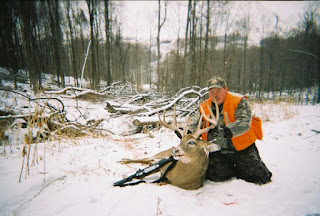 |
| Ohio Whitetail Hunting Preserve Winter Buck, Hidden Hollow Whitetail Preserve |
Like many other wild animals, whitetail deer have adapted to live in the environments they're in. In Ohio, that means dealing with the heat of summer and the frigid winter temperatures. The seasonal change can mean they need to make some behavioral changes, but some biological adoptions take place on their own.
Many behavioral changes are sometimes made as needed and a whitetail might change the habits as the weather worsens. When temperatures are at extreme lows or there is a large amount of snowfall, whitetail deer reduce their activity to only absolute necessary moves. By limiting movementthey are able to lower their metabloic rate which makes their body use less energy and need a lower food intake. They may also seek different shelter. Areas that have low wind and that can offer some over head cover are the most likely bed areas. Places like thickets are common homes for whitetail deer during the harsh winter months.
Before winter hits Ohio whitetail deer do begin to bulk up their bodies. By increasing their food intake it builds up additional body fat to provide additional insulation and energy reserves. This additional fat helps during the times they aren't moving to eat as much and for when food is harder to find. As winter approaches you will also notice whitetail deer change from their summer red-toned fur to the dull brown winter coat. The brown coat tends to be much thicker and plays a very large roll in keeping them warm. The new coat is made of coarse, hollow, dark hairs with a wooly layer of underfur. The underfur provides most of the insulation while the outer coat absorbs most of the available environmental energy. The coarse outer fur also helps manage moisture as it is near waterproof from the sebaceous oil that covers it and keeps snow from penetrating to the deeper underfur.
While deer who are ill or of old age do have a higher risk of not surviving the winter, most whitetails are built to handle the cold. Through Whitetail hunting preserves like Hidden Hollow Whitetail Ranch we are able to study the behavior of whitetail deer and better understand how they change their habits for wintertime survival.
Comments
Post a Comment